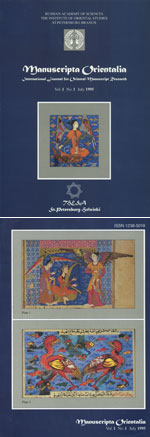|
|
| |

|

|
Kychanov E. Wen-hai Bao-yun: the Book and its Fate // Manuscripta Orientalia. Vol. 1, No 1, July 1995. P. 39—45.
At the beginning of the 18th century there was a wide discussion on the problem of instituting the post of the professor of Oriental languages within the Academy of Sciences. In connection with this discussion M. V. Lomonosov resolutely declared: “Because of our neighbourhood (i.e. Russia's Asian neighbours) we need not just one professor, but an Oriental Academy will prove to be useful”. These words are still true, because in our days the Oriental influence on the development of Russia is still strong.
After the Asiatic Museum had been established within the Russian Academy of Sciences in 1818, purchase, preservation, publication and study of Oriental manuscripts and incunabulae became one of the principal trends of Orientalistics in Russia. In fact, the Asiatic Museum was the direct predecessor of the present-day St Petersburg Institute of Oriental studies. Both in the 19th and the 20th centuries it was impossible to carry out successfull Oriental politics without understanding and knowledge of the history and culture of the peoples of the East. At the same time, from a purely scholastic point of view, penetration into history, culture, linguistics, literature of the peoples of the East is crucial for a deeper understanding of human heritage as the whole. This scholastic work, bringing togethter peoples and continents, adds to the reputation of Russian science for services in preservation of the cultural heritage of Oriental peoples. This work is even more important if we take into account, that some cultural monuments have not survived in their native countries, such as China, India, Japan, in spite of their long cultural tradition. Who could beleive that an unknown version of the popular Chinese novel “The dream of the Red Mansion” would be discovered in the collection of Chinese block-prints in the St Petersburg Institute of Oriental Studies. One more example: some books which belonged to Japanese sailors, shipwrecked by the Camchatka shore, are now the only evidence on what common people liked to read in the 18th century Japan. It is not surprizing therefore, that the Tangut manuscripts of unique value are available in the collection of the St. Petersburg Institute of Oriental Studies…
К содержанию сборника... PDF-файлы PDF-файлы
Полный текст статьи
Ключевые слова
«Вэнь хай бао юнь»
история востоковедения
фонд тангутский
экспедиция П.К.Козлова
|
|
|
|
Случайная новость: Объявления |
|
4 марта 2024 г. (понедельник) в 14:00 состоится заседание Ученого Совета, на котором будет заслушан доклад г.н.с., д.и.н. Т.Д. Скрынниковой «Возрождение имперских амбиций у монголов XVII в. на материале Altan Tobči». |
|
Подробнее...
|
|
|
|
|

